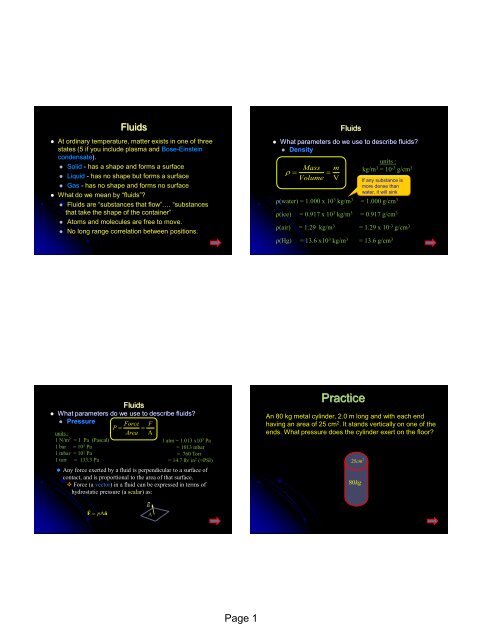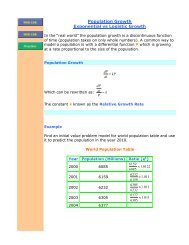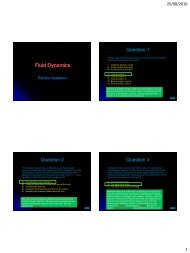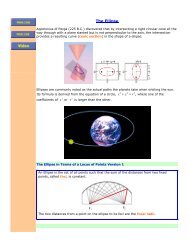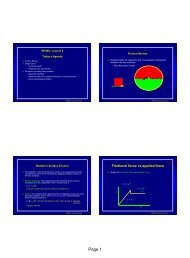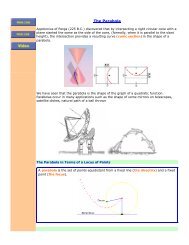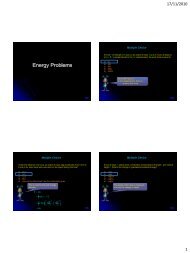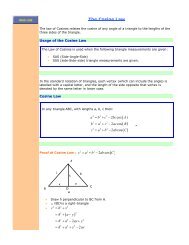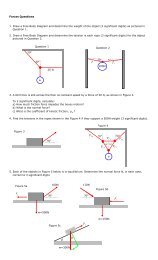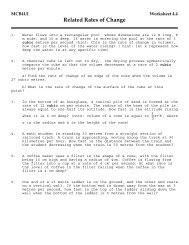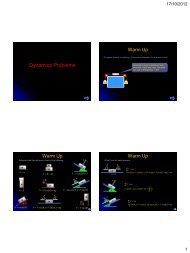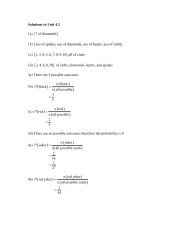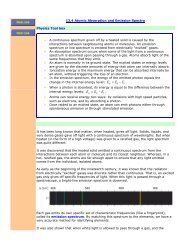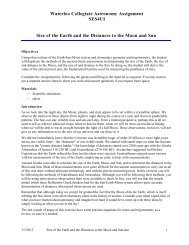You also want an ePaper? Increase the reach of your titles
YUMPU automatically turns print PDFs into web optimized ePapers that Google loves.
Fluids• At ordinary temperature, matter exists in one of threestates (5 if you include plasma and Bose-Einsteincondensate).• Solid - has a shape and forms a surface• Liquid - has no shape but forms a surface• Gas - has no shape and forms no surface• What do we mean by “fluids”?• Fluids are “substances that flow”…. “substancesthat take the shape of the container”• Atoms and molecules are free to move.• No long range correlation between positions.Fluids• What parameters do we use to describe fluids?• DensityMass m Volume Vunits :kg/m 3 = 10 -3 g/cm 3If any substance ismore dense thanwater, it will sink(water) = 1.000 x 10 3 kg/m 3 = 1.000 g/cm 3(ice) = 0.917 x 10 3 kg/m 3 = 0.917 g/cm 3(air) = 1.29 kg/m 3 = 1.29 x 10 -3 g/cm 3(Hg) = 13.6 x10 3 kg/m 3 = 13.6 g/cm 3Fluids• What parameters do we use to describe fluids?• Pressure Force Funits :1 N/m 2 = 1 Pa (Pascal)1 bar = 10 5 Pa1 mbar = 10 2 Pa1 torr = 133.3 PaP Area A1 atm = 1.013 x10 5 Pa= 1013 mbar= 760 Torr= 14.7 lb/ in 2 (=PSI)• Any force exerted by a fluid is perpendicular to a surface ofcontact, and is proportional to the area of that surface. Force (a vector) in a fluid can be expressed in terms ofhydrostatic pressure (a scalar) as:<strong>Practice</strong>An 80 kg metal cylinder, 2.0 m long and with each endhaving an area of 25 cm 2 . It stands vertically on one of theends. What pressure does the cylinder exert on the floor?225cm80kgnFpAˆ n A<strong>Page</strong> 1
SolutionAn 80 kg metal cylinder, 2.0 m long and with each endhaving an area of 25 cm 2 . It stands vertically on one of theends. What pressure does the cylinder exert on the floor?Fp AmgA N 80kg9.8kg 3 22.510m53.110 Pa225 5 5cm cm cm225cm80kg2 25 10 m 5 10 m 4 22510m3 22.510m<strong>Practice</strong>A waterbed is 2m on a side and 30cm deep. Finda) Its weight.b) <strong>The</strong> pressure the waterbed exerts on the floor.WaterbedSolutionA waterbed is 2m on a side and 30cm deep. Finda) Its weight.b) <strong>The</strong> pressure the waterbed exerts on the floor.M VM V41.1810NLet’s rearrangefor Mass, MWater density is 1000 kg/m 3Now, we write weight inW Mgterms of density , Vgvolume and g kg m 1000 3 2.00m 2.00m0.300m9.802 m s SolutionA waterbed is 2m on a side and 30cm deep. Finda) Its weight.b) <strong>The</strong> pressure the waterbed exerts on the floor.FP A41.1810N2m2m3 N2.95102m<strong>The</strong> force is the weightof the bed.Surface area of contactbetween the floor and thebed.Weight is 1.18 x 10 4 N<strong>Page</strong> 2
Specific GravityAn old-fashioned but still very common way of expressingthe density of a substance is to relate it to the density ofwater.Act 3A cork has a volume of 5 cm 3 and weighs 0.03N. What isthe specific gravity of cork?<strong>The</strong> ratio of the density of any substance to the densityof water is known as the specific gravity of thesubstance.If the specific gravity isless than 1, it will float inwater, if it is greater thansubstance1, it will sink.sp.gr waterAct 4 SolutionA cork has a volume of 5 cm 3 and weighs 0.03N. What isthe specific gravity of cork?First let’s find the massw 0.03N3m 3.0610kgg N9.8kgNow for the density33m 3.0610 kg 100cm kgcork 612.2453 3V 5cm 1m mFinally the specific gravitykg612.2453corksp. gr m 0.61kgwater 10003mPressure vs. DepthIncompressible Fluids (liquids)<strong>The</strong> Bulk Modulus of a substance measures the substance’sresistance to uniform compression. It is defined as the pressureincrease needed to cause a relative decrease in volume.• When the pressure is much less than the bulkmodulus of the fluid, we treat the density as aconstant independent of pressure:1. LIQUID: incompressible (density almostconstant)2. GAS: compressible (density depends a lot onpressure)• For an incompressible fluid, the density IS the sameeverywhere, but the pressure is NOTBulk ModulusPB ( V / V )<strong>Page</strong> 3
Pressure vs. DepthIncompressible Fluids (liquids)• Due to gravity, the pressure depends ondepth in a fluid• Consider an imaginary fluid volume (acube, each face having area A)<strong>The</strong> sum of all the forces on this volumemust be ZERO as it is in equilibrium.» <strong>The</strong>re are three vertical forces:• <strong>The</strong> weight (mg)• <strong>The</strong> upward force from the pressureon the bottom surface (F 2 )• <strong>The</strong> downward force from thepressure on the top surface (F 1 )• Since the sum of these forces isZERO, we have: F 2 -F 1 =mgF 1F 2y 1yp 21ASame fluid)p 2mg1 22 1p0F mg F 0F 0mg F FF F mg2 1Pressure vs. DepthIncompressible Fluids (liquids)F Fmg2 1P A PA mg2 1Now since P2A Force=pressure× PA1VgAreaNow since Mass=Density× VolumeP2A P1A y2 y1 AgP P y y g Volume is area x height21 2 1P gh<strong>The</strong> pressure at the bottom of a vertical column is equalto the pressure at the top of the column (P o , Usuallyatmospheric) , plus the pressure due to all the water inthe column of height , h. (density x gravity x height).F 1F 2y 1yp 21ASame fluidp 2mgp0P P0ghGAUGE Pressure• One must be careful when we are talking aboutpressure. Do we want to include atmospheric pressurein our calculations?• If we want the pressure over and above atmosphericpressure, we have P 0 =0. This is called the GaugePressure.• If we need to include atmospheric pressure we use:P 0 =1x10 5 N/m 2 = 100 kPa• Most pressure gauges register the pressure over andabove atmospheric pressure.• For example a tire gauge registers 220 kPa, the actualpressure within the tire is 220 kPa +100 kPa = 320 kPaGauge Pressure in a Tank Filled with Gasoline and WaterWhat is the pressure at point A? At point B?kgAt point A:G 6803mPA P0GghGkg kg m W10000 680 9.83 3 2 10mm m s N 666402mAt point B:10m3 mP P ghB A W WN kg m 66640 1000 9.82 3 2 3mm m s N 960402m<strong>Page</strong> 5
Pascal’s Principle• So far we have discovered (using Newton’s Laws):• Pressure depends on depth: P = g y• Pascal’s Principle addresses how a change inpressure is transmitted through a fluid.Any change in the pressure applied to an enclosed fluid istransmitted to every portion of the fluid and to the walls ofthe containing vessel.Pascal’s Principle• Consider the system shown:• A downward force F 1 is applied to the piston of area A 1 .• This force is transmitted through the liquid to create an upwardforce F 2 .• Pascal’s Principle says that increased pressure from F 1 ,[P=(F 1 /A 1 )] , is transmitted throughout the liquid.F1 F2P A A1 2AF 22 F1A1• Pascal’s Principle explains the working of hydraulic lifts i.e., the application of a small force at one place can resultin the creation of a large force in another. Will this “hydraulic lever” violate conservation of energy?‣ NoYes, but whatgives?Free Energy?Where did thisextra forcecome from?Since A 2 is largerthan A 1 , we havea force multiplier.Let’s check theif the work doneby F 1 equal thePascal’s PrincipleF1F21 1 11 F2A2d2dV112work done by F 2 2F d F d1 1 2 2dA1 1d2A2A 1A 2W F dF AV2F2A2 F dDisplacedvolumesare thesame,so…<strong>The</strong>reforeenergy isconservedWith a hydraulic lever, a given force applied over a givendistance can be transformed to a greater force appliedover a smaller distance.2 W2A d21A2F2 F1A1ACTIn the hydraulic system shown below in the diagram, the 200kgcylinder has a cross sectional area of 100 cm 2 . <strong>The</strong> cylinder onthe right has a cross sectional area of 10.0 cm 2a) Determine the amount of weight (F) you must apply on theright side of the system to hold the system in equilibrium (Stopthe left side from moving down).b) If the left cylinder is pushed down 5.0cm, determine thedistance F will move.c) Determine the mechanical advantage of the system<strong>Page</strong> 6
ArchimedesArchimedes is said to have discovered his principlein his bath while thinking how he might determinewhether the king’s new crown was pure gold orfake.Gold has a specific gravity of 19.3, somewhathigher than most metals, but a determination ofspecific gravity or density is not easy with airregularly shaped object.ArchimedesA 14.7 kg crown has an apparent weight of 13.4 kg whensubmerged in water. Is it gold?<strong>The</strong> apparent weight of the submerged crown, w`, equalsits actual weight, w, minus the buoyant force, F B .w'w FobjectBVg watergVw'w Fw w' FWe can find the specific gravity :B objectwaterBgVobjectVg w w Vg F w w'water water BArchimedes realised that if the crown is weighed inair and weighed in water, the density can dedetermined.objectwater N 14.7kg9.8kgw 11.3w w' N N 14.7kg9.8 13.4kg9.8kg kg This corresponds to adensity of 11,300 kg/m 3(that of lead)Alternate solutionLet’s find thevolume of thedisplaced water(this is also thevolume of thecrown)We can nowdetermine thedensity of the crownw w' F14.7kg 13.4kg g gVcrownmVcrowncrown14.7kg1.310mkg113073mB waterwatergVwaterwater3 kg 1.3kg 1.000 x 103 V m 1.3kgVwater 3 kg 1.000 x 103 m 3 31.310m3 3water<strong>Practice</strong>• A lead weight is fastened to a largestyrofoam block and the combinationfloats on water with the water levelwith the top of the Styrofoam blockas shown.• If you turn the Styrofoam + Pbupside down, what happens?A) It sinks B)styrofoam C)PbstyrofoamPbPbstyrofoamD)styrofoamPb<strong>Page</strong> 9
Have you ever tried to submerge a beach ball (r = 50 cm) in aswimming pool? It’s difficult. How big a downward force must youexert to get it completely underwater?Solution:F gV4 3 gr3 kg m 43 1000 9.83 2 0.5m m s 3 5131N 523kg gExample Problems (2)We are displacingthis much waterI’m ignoring the weight of the beach ball.<strong>The</strong> force is the weight of a 523 kg object.More Fun With Buoyancy• Two cups are filled to the samelevel with water. One of the twocups has plastic balls floating in it.Which cup weighs more?Cup ICup IIArchimedes principle tells us that the cups weigh the same.Each plastic ball displaces an amount of water that is exactlyequal to its own weight.Still More Fun!• A plastic ball floats in a cup of water with half of its volumesubmerged. Oil ( oil < ball < water ) is slowly added to thecontainer until it just covers the ball.Relative to the water level, the ball moves up. Why?waterFor oil to cover the ball, the ball must have “displaced” some water.<strong>The</strong>refore, the buoyant force on the ball increases.<strong>The</strong>refore, the ball moves up (relative to the water).Note that we assume the buoyant force of the air on the ball isnegligible (it is!); the buoyant force of the oil is not.Archimedes SummaryArchimedes Principle states that the buoyant force on asubmerged object is equal to the weight of the fluid that isdisplaced by the object.If the weight of the water displaced is less than the weightof the object (buoyant force is less than the weight ofobject) , the object will sink. Otherwise the object will float,with the weight of the water displaced equal to the weightof the object. F V gBuoyancy fluid submergedVsubmergedVobjectobjectfluid<strong>Page</strong> 11
Fluids in Motion• Up to now we have described fluids in terms oftheir static properties:• Density • Pressure P• To describe fluid motion, we need somethingthat can describe flow:• Velocity v• <strong>The</strong>re are different kinds of fluid flow of varying complexitynon-steady / steadycompressible / incompressiblerotational / irrotationalviscous / idealTypes of Fluid Flow• Laminar flow• Each particle of the fluidfollows a smooth path• <strong>The</strong> paths of the differentparticles never cross eachother• <strong>The</strong> path taken by theparticles is called astreamline• Turbulent flow• An irregular flowcharacterized by smallwhirlpool like regions• Turbulent flow occurs whenthe particles go above somecritical speedTypes of Fluid Flow• Laminar flow• Each particle of the fluidfollows a smooth path• <strong>The</strong> paths of the differentparticles never cross eachother• <strong>The</strong> path taken by theparticles is called astreamline• Turbulent flow• An irregular flowcharacterized by smallwhirlpool like regions• Turbulent flow occurs whenthe particles go above somecritical speedOnset of Turbulent Flow<strong>The</strong> SeaWifS satellite image of avon Karman vortex aroundGuadalupe Island, August 20,1999<strong>Page</strong> 12
Ideal Fluids• Fluid dynamics is very complicated in general (turbulence,vortices, etc.)• Consider the simplest case first: the Ideal Fluid• No “viscosity” - no flow resistance (no internal friction)• Incompressible - density constant in space and timeIdeal Fluids• Streamlines do not meet or cross• Velocity vector is tangent tostreamline• Volume of fluid follows a tube of flowbounded by streamlines• Streamline density is proportional tovelocity• Simplest situation: considerideal fluid moving with steadyflow - velocity at each point inthe flow is constant in time• In this case, fluid moves onstreamlinesstreamline A 2A 1v 1v 2• Flow obeys continuity equationVolume flow rate Q = A·v is constant along flow tube.A 1 v 1 = A 2 v 2Follows from mass conservation if flow is incompressible.<strong>The</strong> Equation of ContinuityContinuityQ: Have you ever used your thumb to control the water flowing fromthe end of a hose?A: When the end of a hose is partially closed off, thus reducing itscross-sectional area, the fluid velocity increases.This kind of fluid behavior is described by the equation ofcontinuity.A four-lane highway merges down to a two-lane highway. <strong>The</strong> officer in thepolice car observes 8 cars passing every second, at 30 mph.How many cars does the officer on the motorcycle observe passing everysecond? A) 4 B) 8 C) 16 All cars stay on the road…Must pass motorcycle tooHow fast must the cars in the two-lane section be going?A) 15 mph B) 30 mph C) 60 mphMust go faster, elsepile up!<strong>Page</strong> 13
ExerciseContinuity of Fluid Flow• A housing contractor savessome money by reducing thesize of a pipe from 1cmdiameter to 1/2cm diameter atsome point in your house.v 1 v 1/2 Assuming the water moving in the pipe is an ideal fluid,relative to its speed in the 1cm diameter pipe, how fastis the water going in the ½ cm pipe?(A) 2 v 1 (B) 4 v 1 (C) 1/2 v 1 (D) 1/4 v 1Fluid In= Fluid Out• Watch “plug” of fluid moving through the narrow part of the tube (A 1 )•Time for “plug” to pass point t = x 1 / v 1• Mass of fluid in “plug” m 1 = Vol 1 = A 1 x 1 or m 1 = A 1 v 1 t• Watch “plug” of fluid moving through the wide part of the tube (A 2 )•Time for “plug” to pass point t = x 2 / v 2• Mass of fluid in “plug” m 2 = Vol 2 =A 2 x 2 or m 2 = A 2 v 2 t• Continuity Equation says m 1 = m 2 fluid isn’t appearing or disappearingA 1 v 1 = A 2 v 2Faucet PreflightA stream of water gets narrower as it falls from a faucet (try it & see).Explain this phenomenon using the equation of continuityFluid Flow ConceptsV 1V 2A 2A 1• Continuity: A 1 v 1 = A 2 v 2• Mass flow rate: Av (kg/s)• Volume flow rate: Av (m 3 /s)• i.e., mass flow rate the same everywheree.g., flow of river“Since the area inside the faucet is large, the velocity of the water will be low. Due tothe equation of continuity, the area of the water has to be lower due to thevelocity increasing outside of the faucet. ”“Velocity and area are inversely proportional. Velocity increases, so area decreases.”Since we have an ideal fluid (incompressible), thenwe can simply use: Av1 1 A2v224<strong>Page</strong> 14
Pressure, Flow and Work• Continuity Equation says fluid speeds up going to smaller opening,slows down going to larger opening• But, if the fluid is moving faster, then it has more kinetic energy.• <strong>The</strong>refore something did work on the fluid to accelerate it (apply aforce)W Fd• Acceleration due to change in pressure. P 1 > P 2• Smaller tube has faster water and LOWER pressure PAd1 1• Change in pressure does work! PV1 1• W = F 1 x 1 –F 2 x 2 = P 1 A 1 x 1 - P 2 A 2 x 2 = (P 1 – P 2 )VIn essence, Bernoulli’s Principle states that where the velocity of a fluid ishigh, the pressure is low and where the velocity is low, the pressure is high.Pressure ACT• What will happen when I “blow” air between the two plates?A) Move Apart B) Come Together C) NothingBernoulli’s EquationFor steady flow, the speed, pressure, and elevation of anincompressible and nonviscous fluid are related by an equationdiscovered by Daniel Bernoulli (1700–1782).It is the application of the conservation of energy. P is the pressure ofthe fluid at the specified spot. y is the vertical height at the specifiedspot, v is the velocity at the specified spot.Pressure, Flow and WorkWork done = Gain in KE + Gain in PE1 2 1 2F1 x1 F2x 2 mv2 mv1 mgh2 mgh12 21 2 1 2P1 A1 x1 P2 A2 x2 mv2 mv1 mgh2 mgh12 21 2 1 2PV1 PV2 mv2 mv1 mgh2 mgh12 2m m 1 2 1 2P1 P2 mv2 mv1 mgh2 mgh1 2 21 2 1 2P1 P2 v2 v1 gh2 gh12 21 2 1 21 2P1 v1 gh1 P2 v2 gh2or P v gh constant2 22Fluid toleft givespressure.Work is done bythe difference inpressureThis is the workdone to move thecoloured fluid fromleft to right<strong>Page</strong> 15
Bernoulli’s Equation1 1P v gh P v gh2 22 21 1 1 2 2 2KineticExternalPotential+ Energy per +Pressureenergy perVolumeunit Volume<strong>The</strong> Fluid is pushedfrom Point 1 to Point 2This sum has the same value at all points along a streamline.Question<strong>The</strong> container below is filled to a height h with liquid of density ρ. <strong>The</strong> atmosphericpressure is P atm , determine the pressure of the fluid at each labelled point .Compare the pressure at point 3 with that at point 5 with A 3 =1/2A 51 2 1 2P1 v1 gh1 P2 v2 gh22 2p p5 atmhp1 patmgh1 234 5p2 p4 p5(Cross sectional area are the same, v 1=v 2=v 3, height are the same, h 1=h 2=h 3)p p gh3atm3Let’s see how1 2 1P1 v1 gh1 P5 v5 2 2 gh52patm1 21 gh v1 gh1 patm v52 2 gh521 2 1gh v1 v52 2222gh v 5v5 2ghp pv5 atmhp1 patmgh1 2Question34 5p2 p4 p5(Cross sectional area are the same, v 1=v 2=v 3, height are the same, h 1=h 2=h 3)p p gh3atm35 2gh<strong>The</strong> container below is filled to a height h with liquid of density ρ. <strong>The</strong> atmosphericpressure is P atm , determine the pressure of the fluid at each labelled point .Compare the pressure at point 3 with that at point 5 with A 3 =1/2A 51 2 1 2A P1 v1 gh1 P2 v2 gh3v3 A5v522 215 3 5 52 A v A v2 2P3 1 v13 gh3 P5 v5 gh52 2v3 2v51 2 1 2P3 v3 P5 v52 2P3 Patm1 2 v5 v3221P3 Patm 2gh 8gh2p3 patm3ghBernoulli ACT• Through which hole will the watercome out fastest?P 1 +gy 1 + ½ v 12= P 2 +gy 2 + ½v 22Note: Outside all three holes the external pressure is the same: P=1Atm (the ρgy term accounts for the pressure of water in column)1 2 1 2gy1 v1 gy2 v22 2y1 2 122gy1 v1 gy2 v22 2y 1y 2 > y 1 v 1 > v 2Smaller y gives larger v. Hole C is fastestABC<strong>Page</strong> 16
Exercise<strong>Practice</strong>• A housing contractor saves somemoney by reducing the size of apipe from 1cm diameter to 1/2cmdiameter at some point in yourhouse.v 1 v 1/2A large bucket full of water has two drains. One is a hole in the side of thebucket at the bottom, and the other is a pipe coming out of the bucket nearthe top, which bent is downward such that the bottom of this pipe is evenwith the other hole, like in the picture below:Though which drain is the water spraying out with the highest speed?1. <strong>The</strong> hole2. <strong>The</strong> pipe3. Same(A) 2 v 1 (B) 4 v 1 (C) 1/2 v 1 (D) 1/4 v 1 For equal volumes in equal times then ½ the diameterimplies ¼ the area so the water has to flow four times as fast. But if the water is moving four times as fast the it has 16times as much kinetic energy. Something must be doing workon the water (the pressure drops at the neck and we recast thework as W=P V = (F/A) (Ax) = F x )Speed is determined by pressure difference wherewater meets the atmosphere. Relevant height is wherethe hole is. Both are exiting at the same height!ExampleA garden hose w/ inner diameter 2 cm, carries water at 2.0 m/s. Tospray your friend, you place your thumb over the nozzle giving aneffective opening diameter of 0.5 cm. What is the speed of the waterexiting the hose? What is the pressure difference between inside thehose and outside?Continuity EquationA 1 v 1 = A 2 v 2v 2 = v 1 ( A 1 /A 2 )= v 1 ( πr 12/ πr 22 )= 2 m/s 16 = 32 m/sBernoulli EquationP 1 +gy 1 + ½ v 12= P 2 +gy 2 + ½ v 22P 1 – P 2 = ½ (v 22– v 12 )= ½ (1000 kg/m 3 ) (1024 m 2 /s 2 – 4 m 2 /s 2 ) = 5.1 10 5 PaBernoulli’s Principle• A housing contractor savessome money by reducing thesize of a pipe from 1cmdiameter to 1/2cm diameter atsome point in your house.v 1 v 1/21) What is the pressure in the 1/2cm pipe relative to the 1cmpipe?(A) smaller (B) same (C) larger<strong>Page</strong> 17
Applications of Bernoulli'sEquationHousehold Plumbing<strong>The</strong> tarpaulin that covers the cargo is flat when the truckis stationary but bulges outward when the truck ismoving.In a household plumbing system, a vent is necessary to equalize thepressures at points A and B, thus preventing the trap from being emptied. Anempty trap allows sewer gas to enter the house.Curveball PitchApplications of Fluid Dynamics• Streamline flow arounda moving airplane wing• Lift is the upward forceon the wing from the air• Drag is the resistance• <strong>The</strong> lift depends on thespeed of the airplane,the area of the wing, itscurvature, and theangle between the wingand the horizontalhigher velocitylower pressurelower velocityhigher pressureNote: density of flow lines reflectsvelocity, not density. We are assumingan incompressible fluid.<strong>Page</strong> 18
Applications of Fluid Dynamics<strong>The</strong> constriction in theSubclavian arterycauses the blood in the regionto speed up andthus produces low pressure.<strong>The</strong> blood movingUP the LVA is then pushedDOWN instead ofdown causing a lack of bloodflow to the brain.This condition is called TIA(transient ischemicattack) or “Subclavian StealSyndrome.Flash FilesPressureBuoyancyFluid FlowBernoulli’s EquationSummary<strong>The</strong>se are the formulas that you need to know:ForceMassPressure = Density =Area VolumeF weightP gym V VgW Fd PAd1 1 PV1 1P = P gh0Archimedes’ Principle: Pascal’s Principle:Bernoulli’s Equation:F V g m g WVBuoyancy fluid submerged fluid fluidsubmergedVobjectWobjectFBuoyancyWork : F d F dVolume :Pr esssure:WobjectfluidobjectW1 1 2 2A d A d1 1 2 2F1 F2A A1 2objectAppearant Weight ObjectContinuity Equation: Av1 1 A2v2 Av is flow rateW1 1P gy v P gy v2 22 21 1 1 2 2 2<strong>Page</strong> 19


